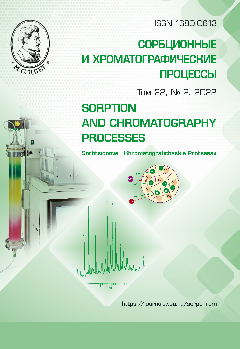The role of the adsorption characteristics of sands in environmental protection from contamination with nickel(II) ions
Abstract
A study was performed of the mechanisms of surface phenomena in the "sand - technogenic runoff" system for the determination of their role in the pollution of coastal zones with nickel (II) ions. Coastal sands from economically significant areas of Vietnam were used as the objects of the study. The experiments were carried out based on simulation modelling using artificially created technogenic effluents.
The obtained results indicate that the degree of retention of nickel(II) ions from an aqueous solution on the surface depends on the rate of solution filtration through a layer of sand and decreases as it increases.
The effect of removing nickel(II) ions from the flow and depositing them on mineral particles depends on the grain size of the sand, its degree of homogeneity, and crystal chemical features. Granulometric and crystal-chemical characteristics, in turn, depend on the geographical features of the sampling site. Sea sand sampled on the coast of Bakbo Bay (South China Sea), which contains almost pure quartz is characterised by the lowest sorbtion of nickel ions. On the surface of river sands, the conditions for the sorption of nickel (II) ions are more favourable, but each sand has its own characteristics.
The analysis of the kinetic regularities shows that a pseudo-first-order model is suitable for describing the mechanism of the surface process, and the found values of the sorption activation energy emphasise the significance of the diffusion stages of the process. The mechanism of the surface process probably involves adsorption and ion exchange between functional groups on the sand surface and nickel ions, and is accompanied by the formation of complexes and deposits on the sand surface. A possible scheme for the stages of the surface process was proposed. All sands were characterized by irreversible interactions; a certain amount of nickel (II) ions always remained on the surface of mineral particles after desorption. Quantitative indicators of desorption indicate that, due to their natural qualities, the studied sands can play an important role in the processes of pollution of coastal zones with nickel(II) ions.
Downloads
References
Gorbunova N.S., Gromovik A.I., Cherepuhina I.V., Terent'eva Ju.Ju., Sorp-tion processes in soils. Study issues and the current state of the problemю Sorbtsionnye i khromatograficheskie protsessy. 2021; 21(2): 265-275. https://doi.org/10.17308/sorpchrom.2021.21/3360. (In Russ.).
Nikiforov A.F., Kutergin A.S., Ni-zamova A.F., Fominyh I.M., Trifonov K.I., Sorption of heavy non-ferrous metals from aqueous solutions with granular filter mate-rials based on siliceous rocks. Vodnoe hozja-jstvo Rossii: problemy, tehnologii, uprav-lenie. 2018; 2: 92-108. https://doi.org/10.35567/1999-4508-2018-2-7. (In Russ.).
Prirodnye sorbenty i kompleksony v ochistke stochnyh vod / Pod red. E.S. Klimova. Ul'janovsk. UlGTU. 2011. 201 p. (In Russ.).
El Haouti R., Anfar Z., Et-taleb S., Benafqir M., Lhanafi S., Alem N., Removal of heavy metals and organic pollutants by a sand rich in iron oxide. Euro-Mediterranean Journal for Environmental Integration. 2018; 3: 1-11. https://doi.org/10.1007/s41207-018-0058-9.
Benjamin M.M., Sletten R.S., Bailey R.P., Bennett T. Sorption and filtration of metals using iron-oxide-coated sand. Water Res. 1996; 30(11): 2609-2620. https://doi.org/10.1016/S0043-1354(96)00161-3.
Hubicki Z., Kołodyńska D. Ion Ex-change Technologies. Chapter 8: Selective removal of heavy metal ions from waters and waste waters using ion exchange meth-ods. Ion Exchange Technologies. 2012; 193-240.
Dudareva G.N., Irinchinova N.V., Dudarev V.I., Adsorption extraction of nickel (II) from industrial aqueous solu-tions. Izvestiya Vuzov. Prikladnaya Khimiya i Biotekhnologiya. 2020; 10(1): 133-139. https://doi.org/10.21285/2227-2925-2020-10-1-133-139 (In Russ.).
Vodjanickij Ju.N. Tjazhelye metally i metalloidy v pochvah. M. GNU Pochvennyj institut im. V.V. Dokuchaeva RASHN. M. GNU Pochvennyj institut im. V.V. Dokuchaeva RASHN. 2008. 86 p. (In Russ.).
QCVN 08-MT:2015/BTNMT / Na-tional technical regulation on surface water quality. Hanoi: Ministry of Natural Re-sources and Environment Vietnam. 2015. 13 p.
Yakovleva A.A., Nguyen T.T., Cal-culation of the average particle size and uni-formity coefficient of coastal sands based on the results of sieve analysis. Molodezhnyj vestnik IrGTU. 2020; 10(4): 69-75. (In Russ.).
Yakovleva A.A., Nguyen T.T., Char-acteristics of Sorption on Surfaces of River Sands with the Participation of Iron(III) Ions. Zhurnal fizicheskoj khimii. 2021; 95(6): 1-6. https://doi.org/10.31857/S0044453721060285. (In Russ.).
Yakovleva A.A., Nguyen T.T., To the question of the barrier qualities of the sands of northern and central Vietnam. Sorption of iron (III) ions. Rossijskij khimicheskij zhurnal. 2020; 64(2): 80-84. https://doi.org/10.6060/rcj.2020642.12. (In Russ.).
Ho Y.S., McKay G., Pseudo-second order model for sorption processes. Process biochemistry. 1999; 4: 451-465.
Ho Y.S., Review of second-order models for adsorption systems. J. Hazard. Mater. 2006; 136(3): 681-689. https://doi.org/10.1016/j.jhazmat.2005.12.043.
Timofeev K.L., Mal'cev G.I., Sviri-dov A.V., The kinetics of sorption of ions of indium, iron and zinc on a modified montmorillonite. Vestnik Moskovskogo Uni-versiteta. Serija 2. Khimija. 2017; 58(3): 135-143. (In Russ.).
Thajeel A.S., Isotherm, kinetic and thermodynamic of adsorption of heavy metal ions onto local activated carbon. Aquatic Science and Technology. 2013; 1(2): 53-77. https://doi.org/10.5296/ast.v1i2.3763.
Azizian S. Kinetic models of sorp-tion: a theoretical analysis. J. Colloid Interf. Sci. 2004; 276(1): 47-52. https://doi.org/10.1016/j.jcis.2004.03.048.
Sjutova E.A., Dzhigola L.A., Research of the kinetic regularities of calcium ions solid-phase concentration by natural sorbents. Sorbtsionnye i khromatograficheskie protsessy. 2020; 20(1): 64-78. https://doi.org/10.17308/sorpchrom.2020.20/2381. (In Russ.).
Ramazanov A.Sh., Esmail G.K., Sveshnikova D.A. Kinetics and thermody-namics of sorption of heavy metal ions on montmorillonite-containing clay. Sorbtsionnye i khromatograficheskie protsessy. 2015; 15(5): 672-682. https://doi.org/10.17308/sorpchrom.2015.15/320. (In Russ.).
Kokotov Yu.A., Pasechnik V.A. Equilibrium and kinetics of ion exchange. L. Chemistry. 1960. 336 p.
Ait Ahsaine H., Zbair M., El haouti R. Mesoporous treated sewage sludge as outstanding low-cost adsorbent for cadmium removal.Desalin. Water Treat. 2017; 85: 330-338. https://doi.org/10.5004/dwt.2017.21310.
Xing S., Zhao M., Ma Z. Removal of heavy metal ions from aqueous solution using red loess as an adsorbent. J. Environ. Sci-China. 2011; 23(9): 1497-1502. https://doi.org/10.1016/S1001-0742(10)60581-5.







